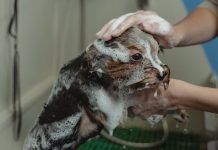Aujeszky’s disease is an acute infectious disease of many domestic and wild mammalian species. It is caused by a virus from the group of herpes viruses characteristic for pigs, SuHV-1.
Pigs are the natural hosts of this virus, while other mammals, such as dogs, cats, raccoons, rabbits, and other rodents can also get the virus, and for them this infection is fatal! The mortality rate in dogs and cats from neurological complications of the disease is 100%.
How did you get fake rabies?
The disease is considered eradicated in much of the US, EU, Canada … where pigs are vaccinated against this disease and there is strong sanitary control, yet the possibility of contact with the virus through contact with feral pigs and rats can never be ruled out – so occasionally epidemics of the disease occur in certain areas and the disease can spread to pets. In our country, this disease is more widespread than in other European countries. The risk group also includes miniature breeds of pigs that reach homes as pets, and can carry this type of herpes virus and spread it to other pets in their environment.
This virus is easily transmitted by contact with the secretions of an infected animal, touching the animals nose-to-nose and by inhalation, then by biting rats and contact with them, and carnivores are most often infected by consuming uncooked pork. Disease transmission e.g. from dog to dog, or dog to man is almost impossible, but it is still advisable to isolate an individual affected by the disease from their environment.
The advice to all owners is not to give fresh pork, pork leftovers, offal and untested products that have not been thermally processed to their pets. Special attention must be paid to hunting dogs, especially those that participate in hunting wild boar, because it can easily occur inadvertently during contact with prey, as well as in dogs and cats that live on farms. This information can be very helpful to the attending veterinarian in diagnosing the disease.
The virus spreads rapidly on the mucous membrane of the mouth and throat of the animal, causing exudation, itching and salivation, which is why the disease was called “false rabies“.
Symptoms of the disease code
– Swelling, redness and increased exudation of the mucous membranes of the mouth and nose, salivation
– Difficulty, rapid and deep breathing, foam
– Severe itching and skin reaction
– Lethargy
– Vomiting
– Elevated temperature
As the disease progresses, the virus spreads to nerve tissue and the brain causing more severe symptoms:
– Difficulty walking
– Strong scratching, up to blood
– Muscle spasms
– Uncontrolled movement of the head and limbs
– Aggression and self-harm
– Loss of consciousness and coma
– Severe neurological problems
– Death
All symptoms develop suddenly, and death usually occurs 48 hours after the onset of the first symptoms.
Diagnosis and therapy
It usually doesn’t take long from the appearance of the first symptoms to a serious condition, when the worried owner calls the vet. A blood test is done and the circumstances that came about by talking to the dog owner are revealed. Based on the obvious signs of the disease, false rabies can be suspected very easily, especially if the pets are regularly vaccinated.
In laboratory diagnostics, the presence of the virus is proven through tissue culture, fluorescence microscopy, or biological testing on rats or rabbits. Unfortunately, during that time, the unfortunate pet usually dies until the results of the confirmation from the reference laboratory arrive, which still takes some time.
As for the therapy, it is mostly supportive – an attempt is made to rehydrate the animal by giving an infusion, with the administration of painkillers, high fever and sedation. In the period when the symptoms worsen, it is necessary to consider the option of humane euthanasia of the pet, since there is no hope for a cure.
Prevention
In addition to regular vaccination, if Aujeszky‘s disease is detected in an area, the infected facility or farm is closed and measures of disinfection and deratization of endangered facilities and facilities in the immediate vicinity are carried out. Every head of cattle and pets in a certain area should be examined extraordinarily. After the expiration of 2 weeks from the last death related to the disease and the implemented prevention measures, it is considered that the infection has stopped in a certain area.
We appeal to pet owners to boil every meat they give to their pets, even from seemingly healthy pigs, because the virus is inactivated at higher temperatures – only then will your pets be safe from this, for them, deadly disease.





